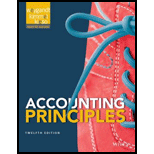
Concept explainers
Accounting for Receivables:
Receivables are defined as the amounts that are due to a firm by its customers and other parties. Receivables include all those assets that arise due to the primary operations of a firm and those representing cash that is to be collected from all external parties who owe money to the firm.
Receivables are broadly categorized into trade-receivables and non-trade receivables. Trade receivables refer to those receivables that occur due to the sale of goods and services in the normal course of business. Non-trade receivables refer to the amounts that occur due to third parties from transactions outside the primary course of business.
To determine: The amount of net credit sales for the period.
Want to see the full answer?
Check out a sample textbook solution
Chapter 9 Solutions
Accounting Principles - Standalone book
- Need help pleasearrow_forwardCan you solve this financial accounting problem with appropriate steps and explanations?arrow_forwardRajiv and Laurie Amin are recent college graduates looking to purchase a new home. They are purchasing a $200,000 home by paying $20,000 down and borrowing the other $180,000 with a 30-year loan secured by the home. The Amins have the option of (1) paying no discount points on the loan and paying interest at 3 percent or (2) paying 1 discount point on the loan and paying interest of 2.5 percent. Both loans require the Amins to make interest-only payments for the first five years. Unless otherwise stated, the Amins itemize deductions irrespective of the amount of interest expense. The Amins are in the 24 percent marginal ordinary income tax bracket. Assume the original facts, except that the amount of the loan is $300,000. What is the break-even point for the Amins for paying the point to get a lower interest rate?arrow_forward
- Can you demonstrate the accurate method for solving this financial accounting question?arrow_forwardI am searching for the correct answer to this general accounting problem with proper accounting rules.arrow_forwardOn November 10 of year 1, Javier purchased a building, including the land it was on, to assemble his new equipment. The total cost of the purchase was $1,200,000; $300,000 was allocated to the basis of the land, and the remaining $900,000 was allocated to the basis of the building. (Use MACRS Table 1, Table 2, Table 3, Table 4 and Table 5.) Note: Do not round intermediate calculations. Round your answers to the nearest whole dollar amount. Problem 10-51 Part e (Static) e. What would be the depreciation for 2024, 2025, and 2026 if the property were nonresidential property purchased and placed in service November 10, 2007 (assume the same original basis)?arrow_forward
- I am looking for the correct answer to this general accounting question with appropriate explanations.arrow_forwardCan you explain the process for solving this general accounting question accurately?arrow_forwardI need help solving this general accounting question with the proper methodology.arrow_forward

 AccountingAccountingISBN:9781337272094Author:WARREN, Carl S., Reeve, James M., Duchac, Jonathan E.Publisher:Cengage Learning,
AccountingAccountingISBN:9781337272094Author:WARREN, Carl S., Reeve, James M., Duchac, Jonathan E.Publisher:Cengage Learning, Accounting Information SystemsAccountingISBN:9781337619202Author:Hall, James A.Publisher:Cengage Learning,
Accounting Information SystemsAccountingISBN:9781337619202Author:Hall, James A.Publisher:Cengage Learning, Horngren's Cost Accounting: A Managerial Emphasis...AccountingISBN:9780134475585Author:Srikant M. Datar, Madhav V. RajanPublisher:PEARSON
Horngren's Cost Accounting: A Managerial Emphasis...AccountingISBN:9780134475585Author:Srikant M. Datar, Madhav V. RajanPublisher:PEARSON Intermediate AccountingAccountingISBN:9781259722660Author:J. David Spiceland, Mark W. Nelson, Wayne M ThomasPublisher:McGraw-Hill Education
Intermediate AccountingAccountingISBN:9781259722660Author:J. David Spiceland, Mark W. Nelson, Wayne M ThomasPublisher:McGraw-Hill Education Financial and Managerial AccountingAccountingISBN:9781259726705Author:John J Wild, Ken W. Shaw, Barbara Chiappetta Fundamental Accounting PrinciplesPublisher:McGraw-Hill Education
Financial and Managerial AccountingAccountingISBN:9781259726705Author:John J Wild, Ken W. Shaw, Barbara Chiappetta Fundamental Accounting PrinciplesPublisher:McGraw-Hill Education





